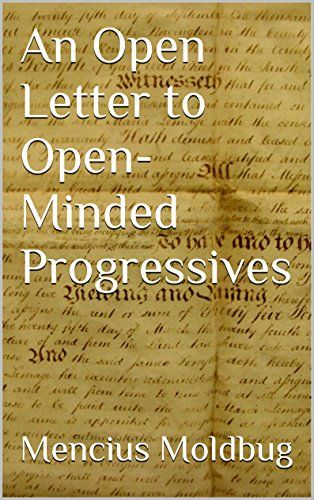An Open Letter Chapter 4 - Dr. Johnson's Hypothesis

Full Title: Chapter 4: Dr. Johnson’s Hypothesis | An Open Letter to Open-Minded Progressives | Unqualified Reservations by Mencius Moldbug
Creator: Mencius Moldbug (Curtis Yarvin)
Publication Date: May 8, 2008
Alternate Link: Audio: An Open Letter to Open Minded Progressives - Chapter 4 - Dr Johnson's Hypothesis - YouTube
Summary:
Dr. Johnson's Hypothesis: "And I have always thought the first Whig was the Devil"
- Yarvin recalls his parents/grandparents called themselves "progressives" aka Whigs
- They were all members of the Communist (aka progressive) Party
- This made Yarvin suspicious of "progress" as something "creepy and weird"
- He had first-hand evidence that there was an international Communist conspiracy
- Modern progressives aren't Communists, rather anti-anti communists
- Think communism is a mistake, yet doesn't condone attacks on it
The relationship between "progressivism" (communism) and American institutions:
- He breaks societies into type 1,2,3 based on relationship between opinion and authority
Type 3: The Open Society (where we want to live)
- Thoughts compete on basis of their resemblance to reality
- Good ideas outcompete bad ideas in a type 3 society because most would rather be clued in rather than deluded.
- Intellectuals compete to see reality as it really is.
- You can expect that the "best thoughts" are readily available for those willing to think them.
- People who want to understand reality will cluster around the truth
Type 1: The Loyal Society
- Thoughts coordinated by government
- Public opinion a matter of state security - because people are freakin' dangerous
- The State establishes 2 categories of thought: Good and bad and reward/punish accordingly
- The State supports official information organs (used to install good thoughts in people's brains, cradle to grave)
- Information organs have one viewpoint, one set of doctrines, one official story = a sypnosis
- There is NO intellectual conflict allowed; disagreement means instability
- A single leader (or single institution of authority) maintains synopsis via executive power
Type 1 Societies are historically right-wing.
- Most common in history
- Default structure of human government: god-king
- Christians called it ceasarpapism
- Anglo-americans: throne and altar state
- American separation of church and state: antipathy for type 1 society
20th Century Type 1 Societies:
- Fascist (ceasaropapist without Christian theism)
- National Socialism: epitome of type 1
- Communist: More institutional, less personal
- Power decays from state (essentially the church) to institutions
21st Century Type 1 Societies:
- China (not such a bad place to live)
- N. Korea (a horrible place to live)
Type 2 Consensus Society: The Cathedral & Synopsis
- Post 1945 western society
- These are like type 1 information organs, but no central coordination
- They consistently push the idea that they ARE a Type 3 society.
- Post 1945 synopsis: The Synopsis
- Institutions producing, spreading the Synopsis (Mainstream academia, journalism, education, entertainment industry): The Cathedral
- The concept of The Cathedral is one of Yarvin's most important contributions to NRX thought.
Consensus Society traits:
- Press and universities control the state (inverse of type 1)
- Formed when central authority in type 1 breaks down
- Hallmark of a Type 2 Society is spontaneous coordination without a clear central authority
- The Cathedral is the dominant information system
- Captures resources/powers of state
- Professors and journalists control public opinion
- The Synopsis strengthens The Cathedral
- There is no way in current society to receive a mainstream education, watch or read the mainstream news, and actually believe them, and not be a Progressive.
- So The Cathedral produces an official information system, which in all other respects resembles a Type I society, but which is not responsible to a central authority.
Coercive Power Distortion vs Attractive Power Distortion
- The Cathedral acts as a power center, but if view divergence occurs (inevitable without outside coordination), they compete in two ways:
- On the basis of intellectual righteousness (truth)
- On the basis of political power (power)
- Truthers are at a disadvantage to those who view everything in terms of power and use them as weapons
Coercive Power Distortion
- Type 1 pathology
- Political power distorts the playing field of ideas, with the State-favored ideals being artificially supported and opposing ideas harshly discouraged.
Attractive Power Distortion
- Type 2 pathology
- Ideas are pushed/favored based on their ability to serve as coalition-organizing ideas.
- From a Type 3 perspective this is just as dangerous because it doesn't promote idea supremacy based on reality.
- Nonsense can be a more effective organizing idea than the truth.
- Virtue signaling: belief in nonsense is an unforgeable demonstration of loyalty
- The Synopsis includes only political propositions which strengthen the Cathedral when adopted (and weaken its enemies), rejecting all other propositions.
Additional Notes on Type 2 Societies
- Expands not in the landscape of truth, but in that of Power
- The first Type 2 movement in modern history: The Reformation
- Through the Reformation, we reach the Enlightenment
- The post 1945 type 2 Western regime appears final and irreversible: whig millennium
- Satisfies demand for power only by expanding
- Whig principles appear noble but are only concerned with seizing power
- In line with the doctor's hypothesis: Whigs (Progressives) are only concerned with their own power rather than state of society.
- They would rather rule in hell than serve in heaven
Tags:
#video #nrx #yarvin